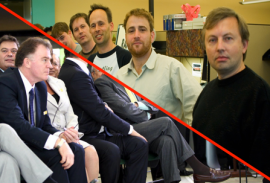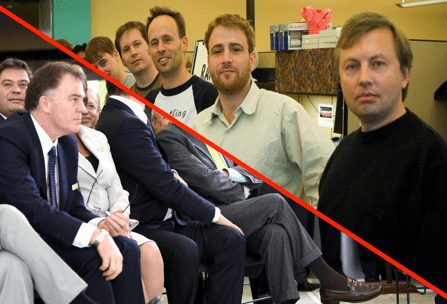Working for an a marketing agency vs client-side marketer – Which path should I choose for my career?


Showing how switching from working client to agency side can help your career progression
After spending the best part of a decade as an in-house client-side marketer, I recently made the decision to experience life as a marketer within an agency. My ambition is to continually develop myself as a rounded marketer, something I’ve tried to demonstrate using the ‘T-shaped marketer’ approach and I felt the change to agency-side marketing would help me to meet my personal development goals.
There are a number of advantages for marketers who experience both agency and client-side marketing and in this post I’ve tried to summarise some of the stand-out differences that I’ve experienced and how they can help marketers looking to develop their careers.
Culture
One of the stand-out differences I found when moving from client to agency-side was the company culture. I’d come from a large company with a very corporate environment so I was immediately struck by the differences in the working environment. In addition to music in the office and more casual dress (t-shirts and shorts vs. suits and ties!), teams interact with one another more openly and there’s a less siloed feel to collaboration.
The culture on the agency-side also feels less hierarchical and more meritocratic. One of the frustrations I often experienced client-side was the dreaded HiPPO (Highest Paid Person’s Opinion). A piece of work or professional opinion could be trumped by someone else’s seniority. And whilst this no doubt occurs in any company to one degree or another, senior figures at the agency certainly appear more open to opinions regardless of whether it’s a junior or senior marketer.
The more laissez-faire culture at an agency can be a double-edged sword. I personally miss the more structured systems in place client-side and whilst the hierarchy could create bureaucratic blockages, you nevertheless had a clear idea of whom the key stakeholders were and how best to deliver for them what is required on any given project or task.
The work
The pace of work agency-side can be much faster. It’s not uncommon to work on multiple clients at a time and therefore multitasking is essential. This has certainly been a personal challenge for me – I was used to working on just one brand before whereas now I’m expected to juggle projects from a wide variety of sectors (from financial services to automotive and FMCG). But at the same time the variety is a huge positive and forces me to keep my skills sharp and look for creative solutions.
It’s also worth noting that on the client-side you are the boss and set the agenda, whilst on the agency-side you are the supplier. This is an important change in dynamic – work must be delivered based on the client’s priorities and challenges must be conducted with tact.
Skill requirements
As a digital marketer, I like to think that many of the skills I have are transferable (and a key reason why I made the switch from client to agency-side marketing). However, what is different is:
a) How the hard marketing skills are applied
b) The different softer skills that are required
On the client-side, even if you have a wide range of knowledge across digital marketing it’s likely you’ll have a narrow focus within the business. You may be expected to specialise in just a few disciplines, e.g. SEO or social media, whilst others focused on others areas, e.g. UX, design and development.
Having strong commercial skills is a key attribute on the client-side. It’s often necessary to sell in ideas to senior stakeholders and the ability to construct a strong business case is essential. In addition, long-term planning is also important – as the custodian of the strategy one must be able to plan 2-5 years (and onwards).
Whilst having a narrow skill focus can also be required agency-side, I’ve personally found that I’m now expected to augment my core skills, enabling me to provide a much more rounded set of recommendations to clients and at the same time develop as a marketer.
Although I believe time-management is essential wherever you work, I’d suggest that this is particularly important as a client-side marketer. As an in-house marketer I was used to spending time working on projects and ‘finessing’ my work before presenting whilst within an agency I have a number of clients with different projects, the timings of which can change at a moment’s notice.
Career progression
How one develops their career on both the client and agency side is of course very much down to each individual and how they manage themselves. However, the company/ corporate structures I’ve experienced on both sides provide an indication of the potential career paths for marketers.
On the client-side, I’ve found there to be a very structured review/ appraisal process. Each review gives marketers the opportunity to understand how they’re performing in relation to their personal objectives, their peers and the organisation overall. Whilst the corporate structure can sometimes be a barrier to progression (for example, if there are established figures in place in senior roles), if you prove your worth and demonstrate value, structures can be changed and new roles created.
Agencies are typically structured like this across the industry:
- Account/ client services
- Planning
- Creative
- Production
- Media buying
There is often more of an entrepreneurial and meritocratic culture and if you can demonstrate great skill and ability there’s an opportunity to progress within your area (for example, within client services you could move from account manager to senior account manager, or within creative from designer to art director) or due to the common agency structure outlined above one can more easily progress by moving between different agencies.
Pay and remuneration
The research I’ve seen tends to indicate that client-side marketers earn more than their agency peers. This may have something to do with the way in which different types of businesses are structured and their respective business models although this is dependent on position and the type of role.
However, whilst pay is a very important factor, the skills and experience one can learn from either client or agency-side is of greater importance and should form part of a marketer’s greater long-term career goals. For example, if your goal is to be a head of digital marketing or creative director in 3, 5 or 10 years time, what are the skills, attributes and competencies you need to acquire? Knowing this will help you identify the right roles to go for and may mean that a lower salary is a worthwhile sacrifice for the potential long-term gains.
Summary of differences
Agency-side:
- Fast-paced
- Work across a variety of brands simultaneously – need to have strong multitasking skills
- Service focused – the clients are top priority
- Relationship management
- Time management to deal with competing priorities
- Negotiating budgets
- Pitches and presentations
- Must be up-to-date with the latest trends and developments to ensure expertise
Client-side:
- One brand to focus on
- Planning and development is crucial
- Can be political and bureaucratic
- Need good influencing skills to work with internal stakeholders
- Develop highly specialised skills in one or two areas
- Can be siloed as a result of specialised centres of excellence
- Manage multiple agencies on campaigns and projects
- Need good commercial skills to sell-in ideas to internal stakeholders
- Can suffer from the HiPPO problem!
Image credits: Fotos GOVBA and Stewart Butterfield
Download Expert member resources – Digital Marketing Agency Toolkit
This set of templates by agency specialist Mark Kelly covers how to improve processes and skills for managing agencies and delivering client projects from pre-sales to implementation.
Access the Digital Marketing Agency Toolkit
From our sponsors: Working for an a marketing agency vs client-side marketer – Which path should I choose for my career?



